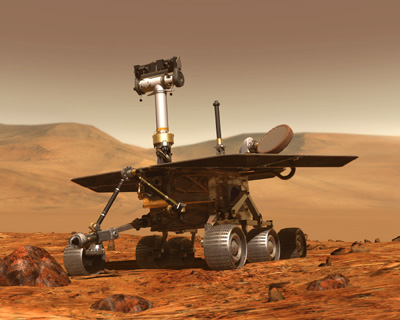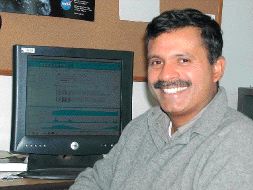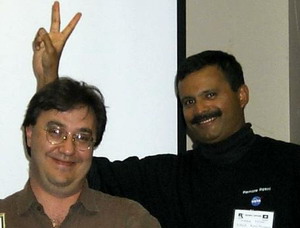 |
|
 |
 |
Click
Jan 11, 2003, NASA
Spirit landed on Mars on Saturday, Jan. 11 and has sent back the highest-resolution color photos ever taken on the surface of the red planet. The 385-pound rover is equipped with a mechanical arm and other tools for experiments.
The rover was scheduled to roll onto the Martian surface Monday, but sections of the air bags that encased the lander are blocking its path. Engineers now expect a delay until Wednesday or later.
When NASA's Spirit rover rolls off the lander and onto the red planet, it will be guided by software that in a sense started at the University of Texas at Arlington.
Mr. Kanna Rajan says there are many risks for the Spirit rover in its mission on Mars. As soon as the Mars Exploration Rovers leave their landers, they will be confronted with completing hundreds of manoeuvres and scientific tasks.
Their software, called MAPGEN (Mixed-Initiative Activity Plan GENerator), for building activity plans with complex constraints and dependencies will be the first published artificial intelligence-based system to command a rover on another planet.
Opportunity, the second rover, is scheduled to arrive on Mars on January 24.
Each rover carries five scientific instruments and a grinding tool. The rovers will spend at least three months investigating two sites that may have once hosted liquid water, which scientists consider a prerequisite for life.
Kanna Rajan, 41, a 1990 UT-Arlington graduate, led a team of more than a dozen scientists to develop the software and will be in the control room helping technicians guide the vehicle across Martian terrain.
As a senior scientist at NASA's Ames Research Center in Moffett Field, Calif., Rajan has led a team over the past 3 1/2 years in designing the software that will guide Spirit and Opportunity, which is scheduled to land on Mars on Jan. 24. The twin rovers are part of an $820 million mission.
Rajan said the team sometimes worked 16- to 18-hour days on the software that will allow NASA technicians to program the rovers with each day's set of instructions.
The order in which they do these tasks will be decided by computer software developed by a National Aeronautics and Space Administration (NASA) team led by Rajan. Rajan says he learned the fundamentals of artificial intelligence -- and concepts he built into the rover's software -- at the University of Texas-Arlington.
When it is, Rajan and a subset of his team will be in the main control room preparing to command the rover with their software, according to the University of Texas, (UTA) Arlington College of Engineering.
Rajan said he and his NASA Ames and Jet Propulsion Laboratory team worked three "very difficult years on this effort, but it's exhilarating to get to this point, ready for surface mission operations, which is really what this mission is about".
"You need to understand the lay of the land," Rajan said, referring to artificial intelligence. "And that lay of the land is really what I picked up at UTA."
Instructions include driving around the planet and scooping up Martian rocks to run experiments on them.
"There's a fair amount of risks," Rajan said. "You can damage the arm, you can damage the rover, and that's the end of the mission."
Rajan said he will be in the control room Monday ready to help with any software glitches.
Rajan, a U.S. citizen originally from India, said that when the mission is over, he wants to spend more time with his wife and their 3-year-old daughter.Rajan said when the mission gets over he would like to spend more time with his wife and their three-year-old daughter.
Rajan is a 1990 University of Texas computer science and engineering master's graduate and now a principal investigator and senior scientist at NASA Ames Research Centre in Moffett Field, California.